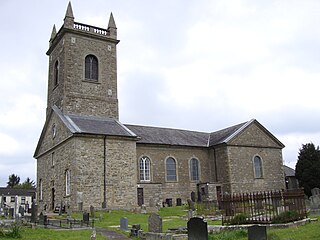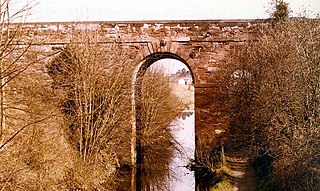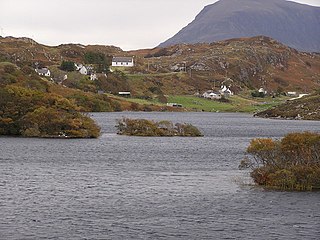Bangor or City of Bangor may refer to:

County Down is one of the six counties of Northern Ireland, one of the nine counties of Ulster and one of the traditional thirty-two counties of Ireland. It covers an area of 961 sq mi (2,490 km2) and has a population of 552,261. It borders County Antrim to the north, the Irish Sea to the east, County Armagh to the west, and County Louth across Carlingford Lough to the southwest.

The Bishop of Clogher is an episcopal title which takes its name after the village of Clogher in County Tyrone, Northern Ireland. Following the Reformation, there are now parallel apostolic successions: one of the Church of Ireland and the other of the Roman Catholic Church.

Ulster English, also called Northern Hiberno-English or Northern Irish English, is the variety of English spoken in most of the Irish province of Ulster and throughout Northern Ireland. The dialect has been influenced by the Ulster Irish and Scots languages, the latter of which was brought over by Scottish settlers during the Plantation of Ulster and subsequent settlements throughout the 17th and 18th centuries.

The N14 road is a national primary road in the Republic of Ireland. The entirety of the route is located in the northwest of Ireland, in County Donegal, connecting Manorcunningham to Lifford in the east. Here it connects to the N15 near the border with Northern Ireland and along the A38 to Strabane in County Tyrone.

Drumbeg is a small village, townland and civil parish on the south bank of the River Lagan in County Down, Northern Ireland. The village is covered by the Lisburn City Council area and forms part of the suburban fringe of Belfast.

Ballyskeagh is a small village and townland situated between Lambeg and Drumbeg in County Down, Northern Ireland. In the 2001 Census it had a population of 186 people. It lies within the Lagan Valley Regional Park and the Lisburn City Council area.

Inver is a small village in County Donegal, Ireland.

Drumbeg is a remote crofting village on the north west coast of Scotland in Assynt, Sutherland, Scottish Highlands and is in the Scottish council area of Highland.

Belfast Upper is a barony in County Antrim, Northern Ireland. To its east lies the barony of Belfast and Belfast Lough, and it is bordered by five other baronies: Belfast Lower to the north-east; Antrim Upper to the north-west; Massereene Lower to the west; Massereene Upper to the south-west; and Castlereagh Upper to the south. The Forth River flows through both Belfast Upper and Lower. The most prominent hills in the barony are Black Hill and Lyle's Hill.

Castlereagh Upper is a historic barony in County Down, Northern Ireland. It was created by 1841 with the division of Castlereagh into two. It is bordered by eight other baronies: Castlereagh Lower and Dufferin to the east; Lecale Lower and Kinelarty to the south; Iveagh Lower, Lower Half, Iveagh Lower, Upper Half, and Massereene Upper to the west; and Belfast Upper to the north.
Dál mBuinne, alias Dál mBuain, meaning the "portion of Buinne", was a medieval Irish Cruthin petty-kingdom that was part of Dál nAraidi of Magh Line in the over-kingdom of Ulaid. Their eponymous ancestor was Buinn, son of the legendary Ulaid king Fergus mac Róich. It consisted in whole or part of a trícha cét. Dál mBuinne is Anglicised as Dalmunia and Dalboyn, the latter of which became the name of a medieval deanery.
On 28 March 1991 a member of the Ulster Volunteer Force (UVF), a loyalist paramilitary group, shot dead three Catholic civilians at a mobile shop in Craigavon, County Armagh, Northern Ireland. The gunman boarded the van and shot two teenage girls working there, then forced a male customer to lie on the pavement and shot him also. The killings were claimed by the "Protestant Action Force", who alleged the mobile shop was owned by an Irish republican. Staff said they had been harassed by Ulster Defence Regiment (UDR) soldiers for not serving them.

On 14 November 1991 the Ulster Volunteer Force (UVF), a loyalist paramilitary group, shot dead three civilians in Craigavon, County Armagh, Northern Ireland. The three men were driving home from work at the Hyster forklift factory.
Samuel Hemphill was an Anglican priest in Ireland. He was born in Springhill, Killenaule, County Tipperary. He was the son of Robert Hemphill of Springhill, Killenaule and Annette Sarah, daughter of Samuel Alleyne Rothwell, of Newtown County Meath.
This page is based on this
Wikipedia article Text is available under the
CC BY-SA 4.0 license; additional terms may apply.
Images, videos and audio are available under their respective licenses.










